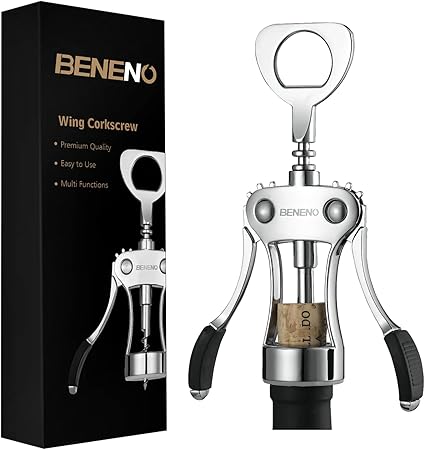Wine Aeration: How Aerators Enhance Your Wine Experience
Wine aeration is a crucial process that can dramatically improve your wine's flavor, aroma, and overall drinking experience. Learn how aerators work, when to use them, and how they can transform your wine from good to exceptional.
The Science of Wine Aeration
Wine aeration is the process of exposing wine to oxygen, which triggers chemical reactions that enhance the wine's characteristics:
- Softens Tannins: Reduces harsh, bitter flavors
- Releases Aromas: Unlocks complex bouquet compounds
- Improves Flavor: Enhances fruit and spice notes
- Reduces Sulfites: Minimizes chemical aftertaste
Featured Product: Rabbit Wine Aerator and Pourer

Rabbit Wine Aerator and Pourer
Clear and stainless steel design wine aerator and pourer. Easy to use for enhancing wine flavor and providing smooth pouring experience with professional quality results.
View on AmazonTypes of Wine Aerators
Pourer Aerators
The Rabbit Wine Aerator is a pourer-style aerator that aerates wine as you pour, providing immediate results without waiting time.
Handheld Aerators
Portable devices that aerate wine directly in the glass, perfect for individual servings and tastings.
Decanter Aerators
Built-in aerator systems in decanters that combine aeration with traditional decanting benefits.
Electric Aerators
Powered devices that use fans or pumps to force air through wine for rapid aeration.
When to Use Wine Aerators
Young Red Wines
Young red wines benefit most from aeration:
- Cabernet Sauvignon: Softens aggressive tannins
- Syrah/Shiraz: Enhances spice and fruit notes
- Malbec: Improves fruit expression
- Zinfandel: Reduces jammy characteristics
Full-Bodied Whites
Some white wines also benefit from aeration:
- Chardonnay: Enhances oak and fruit balance
- Viognier: Releases floral aromas
- White Rhône Blends: Improves complexity
Wines That Don't Need Aeration
Some wines are best served without aeration:
- Delicate Whites: Sauvignon Blanc, Pinot Grigio
- Light Reds: Pinot Noir, Beaujolais
- Sparkling Wines: Champagne, Prosecco
- Very Old Wines: Fragile, already oxidized
How Aerators Work
The Aeration Process
Wine aerators work by:
- Creating Turbulence: Wine flows through narrow channels
- Increasing Surface Area: Wine spreads into thin streams
- Introducing Oxygen: Air mixes with wine molecules
- Triggering Reactions: Chemical changes occur instantly
Aerator Design Features
Quality aerators include:
- Multiple Channels: Increase oxygen exposure
- Stainless Steel Construction: Durable and non-reactive
- Smooth Flow: Prevents splashing and spills
- Easy Cleaning: Simple maintenance
Complementary Wine Service Accessories
Complete your wine service setup with these essential accessories:
Aeration vs Decanting
When to Use Aerators
Choose aerators for:
- Immediate Service: No waiting time required
- Individual Glasses: Perfect for single servings
- Convenience: Easy to use and clean
- Consistency: Reliable results every time
When to Use Decanting
Choose decanting for:
- Sediment Removal: Older wines with particles
- Gradual Aeration: Controlled oxygen exposure
- Presentation: Elegant service experience
- Temperature Adjustment: Wine warming
Maximizing Aeration Benefits
Proper Usage Techniques
Get the most from your aerator:
- Pour Slowly: Allow maximum oxygen exposure
- Hold Steady: Maintain consistent flow
- Clean Regularly: Prevent flavor contamination
- Store Properly: Keep aerator clean and dry
Timing Considerations
Consider aeration timing:
- Immediate Effect: Aerators work instantly
- Peak Timing: Best results within 30 minutes
- Wine Type: Different wines need different timing
- Personal Preference: Taste and adjust
Cleaning and Maintenance
Keep your aerator in perfect condition:
- Rinse Immediately: After each use
- Warm Water: Use mild detergent if needed
- Air Dry: Prevent water spots
- Store Safely: Protect from damage
Common Aeration Mistakes
Avoid these common errors:
- Over-Aeration: Too much oxygen can harm delicate wines
- Wrong Wine Type: Not all wines benefit from aeration
- Poor Cleaning: Dirty aerators affect taste
- Incorrect Usage: Follow manufacturer instructions
Conclusion
Wine aeration is a powerful technique that can transform your wine experience by enhancing flavors, aromas, and overall enjoyment. The Rabbit Wine Aerator and Pourer provides an excellent solution for immediate aeration with professional results.
Remember, aeration is both an art and a science. Experiment with different wines and techniques to discover how aeration can enhance your personal wine preferences and create memorable tasting experiences.
Ready to Enhance Your Wine Experience?
Explore our complete collection of wine aerators and service accessories.
View All Products


